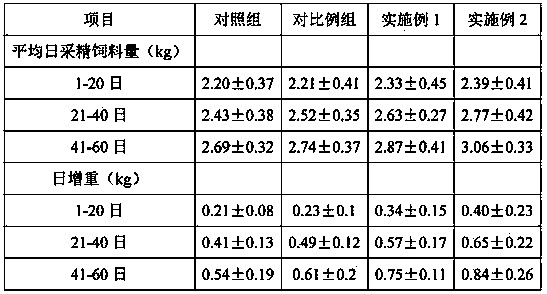Anti-mycotoxin feed additive for cattle
A feed additive and anti-mold technology, applied in animal feed, animal feed, application, etc., can solve the problems of inability to ensure mold adsorption effect, unstable effect, and limited adsorption force, so as to improve animal immunity and feed intake , the effect of preventing mildew
- Summary
- Abstract
- Description
- Claims
- Application Information
AI Technical Summary
Problems solved by technology
Method used
Image
Examples
Embodiment 1
[0023] An anti-heat stress feed additive for beef cattle, weighing 12 parts of Scutellaria baicalensis, 10 parts of cloves, 10 parts of mint, 15 parts of bamboo leaves, 1.5 parts of tea polyphenols, 5.5 parts of sodium diacetate, and nano-montmorillonite by weight 35 parts, 10 parts of active Saccharomyces cerevisiae. Mix Scutellaria baicalensis, cloves, mint, and bamboo leaves for ultrafine grinding, pass through a 60-mesh vibrating sieve, and then stir evenly with tea polyphenols, sodium diacetate, and nano-montmorillonite, dry at 60°C, sterilize, cool, and then mix with The active Saccharomyces cerevisiae is mixed evenly and packaged.
Embodiment 2
[0025] An anti-heat stress feed additive for beef cattle, weighing 12 parts of Scutellaria baicalensis, 10 parts of cloves, 10 parts of mint, 15 parts of bamboo leaves, 1.5 parts of tea polyphenols, 5.5 parts of sodium diacetate, and nano-montmorillonite by weight 45 parts, 20 parts of active Saccharomyces cerevisiae. Mix Scutellaria baicalensis, cloves, mint, and bamboo leaves for ultrafine grinding, pass through a 60-mesh vibrating sieve, and then stir evenly with tea polyphenols, sodium diacetate, and nano-montmorillonite, dry at 60°C, sterilize, cool, and then mix with The active Saccharomyces cerevisiae is mixed evenly and packaged.
Embodiment 3
[0027] An anti-heat stress feed additive for beef cattle, weighing 10 parts of Scutellaria baicalensis, 8 parts of cloves, 12 parts of mint, 18 parts of bamboo leaves, 5 parts of tea polyphenols, 8 parts of sodium diacetate, and nano-montmorillonite in parts by weight 30 parts, 25 parts of active Saccharomyces cerevisiae. Mix Scutellaria baicalensis, cloves, mint, and bamboo leaves for ultrafine grinding, pass through a 60-mesh vibrating sieve, and then stir evenly with tea polyphenols, sodium diacetate, and nano-montmorillonite, dry at 60°C, sterilize, cool, and then mix with The active Saccharomyces cerevisiae is mixed evenly and packaged.
PUM
 Login to View More
Login to View More Abstract
Description
Claims
Application Information
 Login to View More
Login to View More - R&D
- Intellectual Property
- Life Sciences
- Materials
- Tech Scout
- Unparalleled Data Quality
- Higher Quality Content
- 60% Fewer Hallucinations
Browse by: Latest US Patents, China's latest patents, Technical Efficacy Thesaurus, Application Domain, Technology Topic, Popular Technical Reports.
© 2025 PatSnap. All rights reserved.Legal|Privacy policy|Modern Slavery Act Transparency Statement|Sitemap|About US| Contact US: help@patsnap.com


